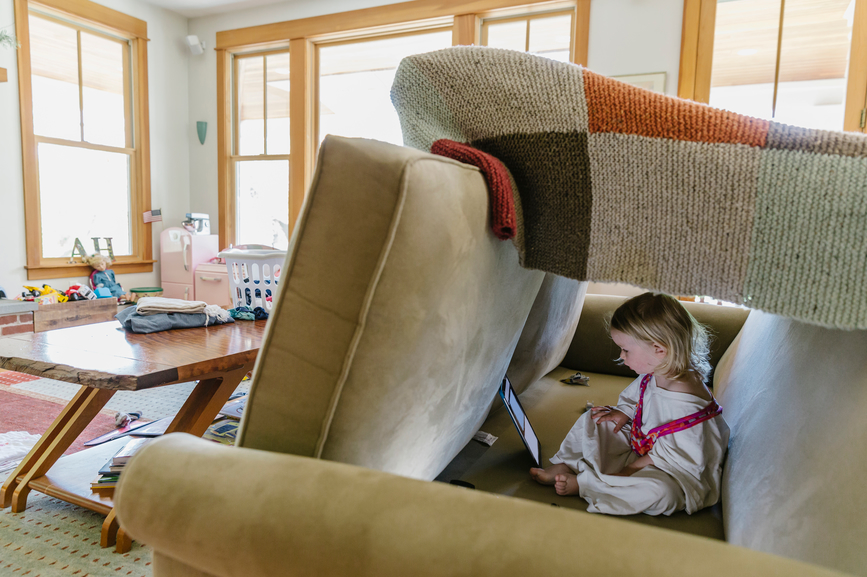
10 Tips For Transitioning Kids Off Screens (Without Tantrums)
Written by Gabrielle McHarg, PhD and Katelyn Blocker, PhD
Photography by Photo by Raymond Forbes
We’ve all seen it—the tears, scrunched up faces, and tantrums that result from those dreaded words “time to put the tablet away.” One of the biggest frustrations in parenting a young child is that moment when it’s time to turn off the screens and transition to doing something else. We have good news: it doesn’t have to be so hard! Read on for a few tips and tricks to help you successfully transition your little one when screen time is over.
WARNING! TRANSITION AHEAD
Transitions are always easier when we know they are coming and what to expect on the other side. This is true no matter how old you are, but is especially important for young children. Give kids incremental warnings in advance of the transition, and make sure they know what they’re transitioning to, not just that they have to turn off the screen. For example, you might say “You have 10 minutes left with your tablet, then it’s time to get ready for the park.”
SPEAK THEIR LANGUAGE
Young children may not yet understand units of time in any meaningful way. Therefore, it can be really helpful to use units of time that make sense to kids as you help them prepare for the transition. Say things like “once Elmo says goodbye, we are going to turn the TV off” or “one more song and then the tablet goes night-night.” Visual indicators of time such as digital timers and hourglasses are great tools for transitions, too!
ENTERTAIN AS YOU GO
Doing something fun as you transition from screen time to another activity can make all the difference! Whether it’s a game of “I Spy” or “Follow the Leader,” or even just singing a favorite song or reading a preferred book, transition moments can be some of the most fun on any day!
FROM FUN TO FUNNER
Screen time is highly stimulating and is often something kids look forward to. If you ask children to turn off their screens and then immediately do something they don’t love doing, like cleaning up or taking a bath, you’re making the transition harder on yourself. Instead, choose a preferred activity as a buffer!
STICK TO IT
Whether their protests indicate it or not, kids need you to be consistent and stick to your word. If you say you’re going to turn the TV off after 2 episodes of Bluey, actually turning it off after 2 episodes makes for a much smoother transition—if not this time, then definitely next time! When you waver, kids learn that they can sway you with words or tantrums, which, ultimately, makes your job more difficult the next time you need to transition. Hang in there and stick with it—you and your kids will thank you later!
BRING IT INTO PERSPECTIVE
Young kids’ sense of time and future aren’t yet fully developed, and so it may feel like this is their only opportunity for screen time, especially if screen time isn’t part of a regular routine. It may be helpful to remind kids of the next time they will have the chance to play their game or watch their show.
OUT OF SIGHT, OUT OF MIND
If possible, it can be helpful to transition to a screen-free location after screen time, and to keep some areas permanently screen-free, such as outdoor play areas and bedrooms. This is especially true if someone else is using screens in the room (like an older sibling), which might make it more frustrating and difficult for your little one to understand why they can’t.
I WANNA BE LIKE YOU
If kids’ tablet time ends, put yours away, too. Show your child when you set a time limit on your device use, and roleplay strategies you want them to use during their transitions, such as putting a device away in a drawer or turning it off. Young children want to be just like you, so if you’re on your phone all day long and protest when it’s time to put it away, kids will have trouble, too.
LEAVE THE SCREENS BEHIND
Teach kids to transition from one activity to another, regardless of what those activities are, in the same way—without screens! Instead of transitioning from living room tablet time to the dinner table while walking with the tablet, make a clean cut from tablet time to a fun transition to family screen-free dinner!
REINFORCE, REINFORCE, REINFORCE
Offer praise and other forms of positive reinforcement when a transition goes smoothly to encourage the same behavior in the future! This might be an immediate reward (as simple as a high-five or a “Good job!”) or a star chart (ex: with a special treat or reward after 5 stars). You know your child best, so you can structure these rewards based on what motivates them the most and what you can maintain. Keep it interesting! At first, reinforcing your child each and every time will help get good habits started, but in order to develop stronger internal motivation, over time you might try offering intermittent rewards of varying degrees.
Since its inception in 2013, Children and Screens: Institute of Digital Media and Child Development, has become one of the nation’s leading non-profit organizations dedicated to advancing and supporting interdisciplinary scientific research, enhancing human capital in the field, informing and educating the public, and advocating for sound public policy for child health and wellness. For more information, head over to childrenandscreens.com.
Share this story




